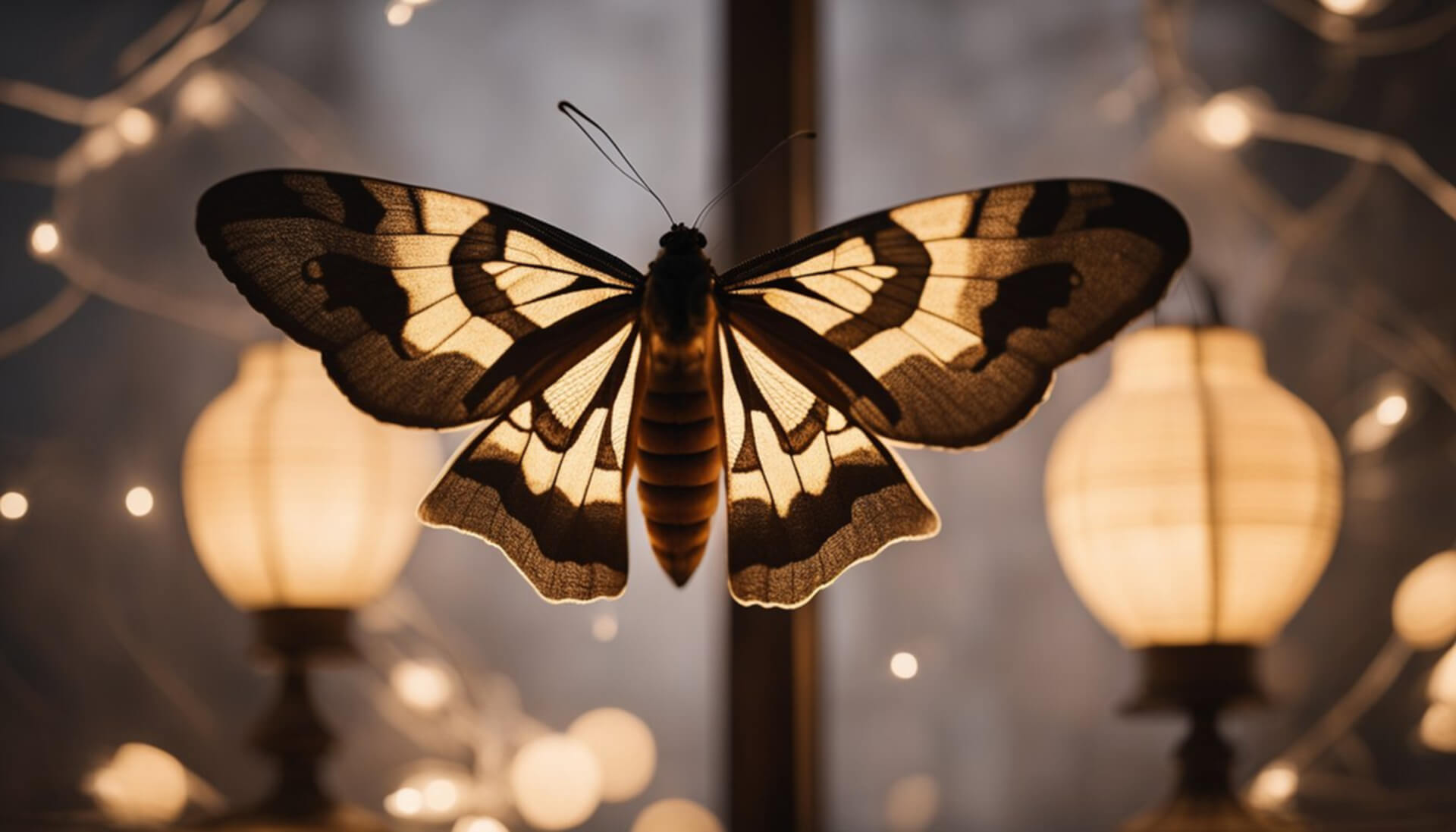In many cultures, the concept of a spirit animal guides and supports human emotions and experiences. The moth, a nocturnal insect, is a prominent example of this. Its attraction to light and transformation from caterpillar to winged beauty resonates with themes of change, adaptation, and seeking truth in one’s journey.
Spirit animals like the moth offer insight into our subconscious. They encourage us to embrace our vulnerabilities while reminding us of life’s constant flux and the necessity of adapting to thrive.
The symbolism of the moth extends to various common moths, such as the Luna Moth or the Atlas Moth. Each has distinct meanings and cultural significance. Encounters with these creatures, whether in dreams or the physical world, often prompt introspection.
As humans reflect on such experiences, they relate the moth’s behavior to human emotions, personal development, and the longing for transformation. From guiding us through reflective and meditative practices to playing a crucial role in ecosystems, the moth spirit animal embodies many interpretations that pertain to both the metaphysical and practical aspects of life.
Spiritual Significance

The moth embodies significant spiritual meaning as a spirit animal and symbolizes the process of transformation and change. It signifies a journey from an old phase to the beginning of a fresh and enlightened one, much like its own metamorphosis from caterpillar to winged creature.
The presence of a moth spirit animal can indicate a time to trust the instincts that guide individuals toward growth and rebirth.
In spiritual practice, meditation with the moth can help one tap into their subconscious, unveiling their inner wisdom and truth about their relationships and emotions.
This spirit guide encourages the embrace of vulnerability and serves as a comforting presence when navigating the uncertainty of personal change.
Intuition and inner guidance are associated with the moth, a creature that navigates the night with an unseen sense of direction and purpose. Moth energy imbues one with determination and passion, inspiring optimism and hope even in dark times.
For those seeking spiritual enlightenment, the moth acts as a reminder that transformation often requires letting go of old habits to discover joy and comfort. The spirit of the moth advocates for an undying belief that the universe supports their journey toward truth and love.
- Healing: Reflects a comforting presence that fosters emotional and spiritual healing.
- Instincts: Moths are guided by solid instincts, which they share with humans to trust their path.
- Camouflage: They highlight the importance of adaptation and protection through spiritual camouflage.
- Enlightenment: The moth is a beacon for those seeking enlightenment, demonstrating the power of faith in the intangible.
Symbolism of the Moth
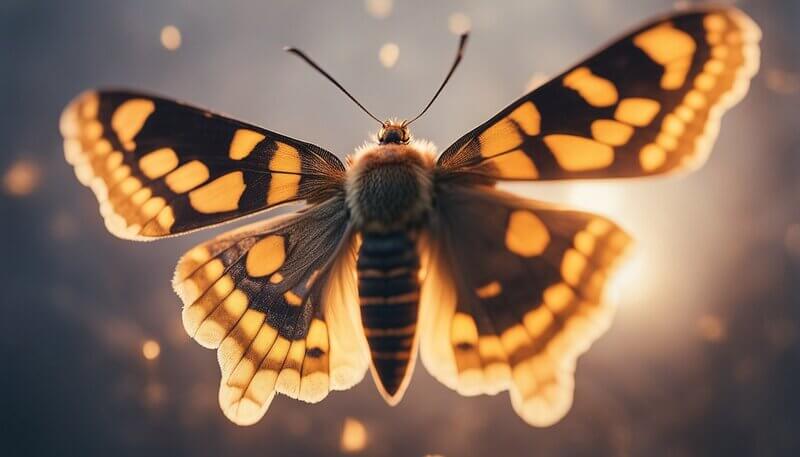
Moths are rich with symbolic meanings. They are often associated with transformation, attraction to light, and their duality in appearance. In different cultures, they serve as powerful spirit animals with distinct characteristics and symbolic implications.
Moth Symbolism and Meaning
Moths have long been symbols of personal growth and transformation. In many traditions, the moth represents change, grace, and the struggle inherent in life’s cycles. They embody the idea of spiritual evolution, with their journey from caterpillar to flying adult likened to human spiritual enlightenment stages.
Furthermore, these insects are often seen as carriers of hidden knowledge and divination, guiding individuals in uncovering truths and mysteries.
Light and Attraction
One of the moths’ most notable behaviors is their attraction to light and flames, which has a rich symbolic meaning. This behavior can symbolize positive aspects such as guidance, hope, and the search for joy in the darkness.
However, it can also represent a warning against blind faith or the risks in being lured towards misleading or dangerous pursuits.
Color and Appearance
The color and appearance of a moth are symbolic in many cultures. Darker moths, which often flutter near lights at night, are sometimes associated with fear or death, while more vibrantly colored moths can signify dance, joy, and creativity.
The perception of moths as nocturnal and discreet can invite interpretations of introversion, mystery, and the unseen.
Life Cycle and Metamorphosis
A moth’s life cycle and metamorphosis are perhaps its most symbolic aspects. They transform dramatically from a caterpillar to a pupa and finally into a moth, which signifies the power of profound change and the potential for rebirth.
In some traditions, this cycle is a metaphor for spiritual transformations, suggesting that a person must experience phases of profound change to achieve proper personal growth.
Common Moths in Myth and Culture

Moths have been prominent symbols in various cultures, each with its beliefs and mythologies. These creatures have captivated human imagination, from the ethereal Luna Moth to the enigmatic Black Witch Moth. The Peppered Moth also plays a significant role in the scientific understanding of evolution.
Luna Moth Significance
The Luna Moth is often associated with the moon and its lunar phases. Due to its metamorphosis life cycle, it is seen as a symbol of transformation and a silver lining. Some cultures consider the appearance of a Luna Moth in dreams to be a message from the subconscious, akin to the moth totem, which embodies personal transformation and the pursuit of dreams.
Black Witch Moth Beliefs
The Black Witch Moth represents different omens and spiritual messages in various cultures. For example, in some Latin American cultures, encountering a Black Witch Moth is believed to be a precursor to death or misfortune. However, the black moth’s meaning can also symbolize hiding one’s true self or concealing secrets, much like how moths navigate by hiding in the shadows.
Peppered Moth and Evolution
The Peppered Moth is a classic example in the scientific community, illustrating natural selection. The fluctuation in its population’s coloration during the Industrial Revolution—where darker moths became more common due to industrial soot—exemplifies evolution.
Moth mythology sometimes overlooks the Peppered Moth, yet its impact on understanding adaptive traits remains significant.
Moths in Dreams and Subconscious
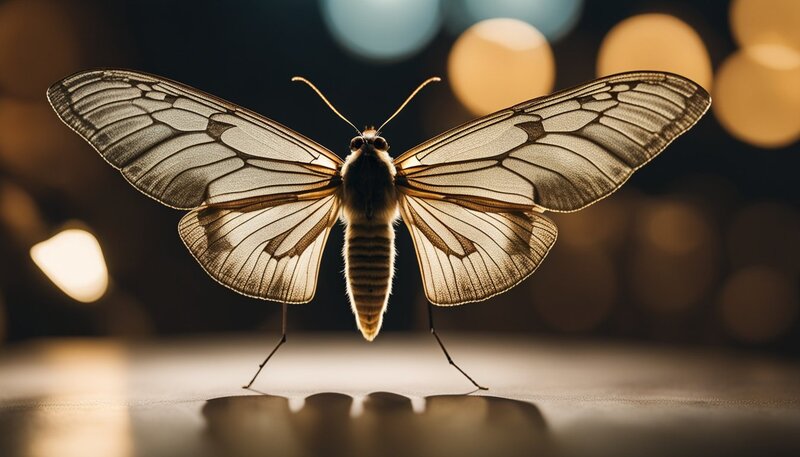
Symbolism of Moths in Dreams
When moths appear in dreams, they often carry symbolic meanings related to the subconscious. A common moth dream scenario involves them flying towards a light, representing a desire for clarity, inspiration, or enlightenment.
Related: Free Dream Dictionary
Dreaming about moths may indicate that the dreamer is searching for truth or understanding the universe’s secrets.
Subconscious and Moth Imagery
The moth’s nocturnal nature links it to the moon, often associated with intuition, instincts, and the hidden aspects of one’s personality. In the subconscious mind, the moth might guide individuals to uncover their passions or to listen to their inner voice.
Moths in dreams can also suggest a connection to the afterlife or the presence of spirits.
Positive Associations
Despite their attraction to light, moths are not simply chasing illumination; they also embody positive attributes such as optimism and the ability to find the silver lining in difficult situations. They sometimes reflect a person’s internal transformation or signal a change ahead.
Moth Dreams and Afterlife
Some cultures believe that moths in dreams are messengers or symbols of the afterlife. A moth’s unexpected presence might signify a visit from ancestors’ spirits, offering comfort or guidance.
Moth Spirit Animal as a Totem
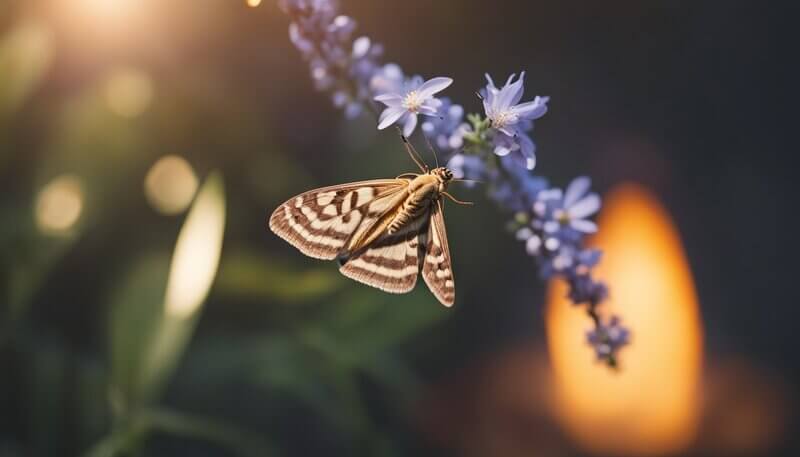
The Moth Totem symbolizes transformation and the delicate balance between light and darkness. Those with the Moth to the Totem animal often navigate life with a unique blend of optimism and intuition.
Individuals drawn to the Moth as their power animal tend to have a deep connection with the moon and are guided by their instincts. They usually embark on a journey toward personal growth and understanding.
Moths are seen as messengers, indicating it’s time for inner reflection and transformation, much like the dragonfly. This transformation might involve leaving behind old habits or thoughts in search of better ones, symbolizing a metaphorical rebirth—akin to the Moth’s evolution from caterpillar to winged adult.
Related: How to Find Your Spirit Animal
The soft and unassuming presence of the moth, coupled with its attraction to light, provides a powerful symbolic meaning. It suggests that even in darkness, there is hope and the potential for love and passion.
The Moth Totem animal encourages individuals to trust their path, even if it leads toward the unknown.
Those who resonate with the Moth Power Animal are believed to have intrinsic abilities to navigate the afterlife and comprehend mysteries beyond the mortal realm.
The Moth’s constant pursuit of light reminds us to always seek out the positives in life and the light within ourselves.
Embracing the Moth as a friend and totem means embracing change. It’s a call to release fears and move towards the light of knowledge with confidence and trust in one’s instincts.
Interpreting Moth Encounters
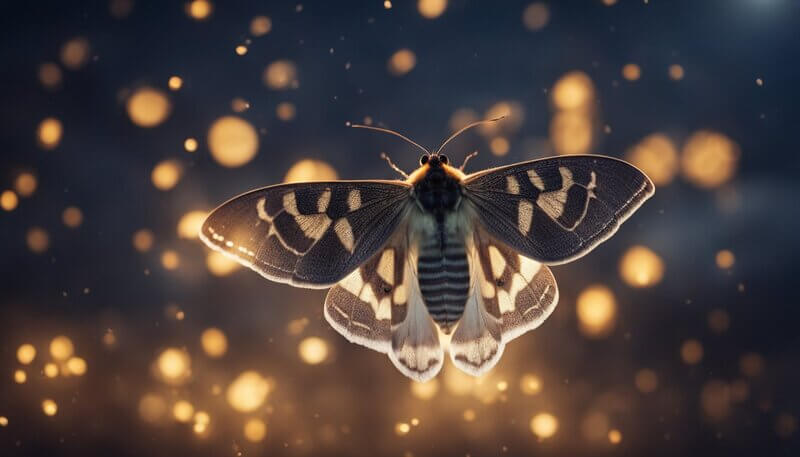
When moths appear in your life, they often carry powerful messages regarding intuition and change, urging one to follow their instincts and be open to personal transformation.
Moths Around the Home
When moths are frequently encountered at home, they could signal the need to inspect one’s emotional foundation and intuition.
A moth’s attraction to light can symbolize a person’s determination to reach higher awareness or transformation within their personal space.
Observing the rooms where moths are found can also offer insights into aspects of one’s life that may require change or personal growth.
- Kitchen: May symbolize nurturing of passions or relationships.
- Bedroom: Often relates to intimacy and vulnerabilities.
These sightings encourage residents to listen to their instincts about their home life’s direction.
Moths and Personal Interactions
Encounters with moths during social situations or personal interactions can be a gentle reminder to stay faithful to one’s values and trust their psychic abilities for guidance in relationships.
The moth’s presence can prompt individuals to be attentive listeners and to tune in more deeply to their attraction toward others.
- Casual encounters may signal an opportunity to assess one’s emotional responses.
- More meaningful interactions might highlight the significance of one’s current life changes.
In both contexts, the moth is a symbol urging individuals to remain true to their course and embrace the determination required for significant life changes.
Moths and Human Emotion

Moths, through their symbolism, have been closely tied to a spectrum of human emotions, ranging from comfort to anxiety and joy. This section examines the interaction between moths and human feelings, emphasizing their roles in various cultural contexts.
Moths and Comfort
Moths often evoke a sense of comfort in the human heart, symbolizing hope and faith. They are seen as messengers guiding individuals through times of change, representing the ability to find light and positivity amidst darkness.
In various cultures, the presence of a moth, especially in a home, can be interpreted as a visit from an ancestor, providing reassurance and a unique form of emotional comfort.
Lepidopteran Anxiety
Yet, the very fragility of moths can also mirror human vulnerabilities and insecurities.
For some, moths induce a form of anxiety known as lepidopteran anxiety. The erratic flight patterns and fluttering of wings could generate irritation or fear.
These insects remind people of their delicate nature and the care needed to navigate life’s trials without succumbing to fear.
Attraction to Light and Joy
Moths are renowned for their attraction to light, which can be paralleled with the human attraction to finding joy and passion.
This behaviour symbolizes the human dance with joy—a gravitation towards things that uplift spirits and provide comfort.
The moth’s pursuit of light transcends its literal context to embody a spiritual quest. It often encourages individuals to follow their faith and inner light to achieve emotional fulfillment.
Ecosystem and Environmental Impact

Moths, as nocturnal creatures, play a crucial ecological role in their habitats. They serve as a vital food source for predators, including bats, birds, and other insects.
Hummingbirds, specifically, may consume moths during their migratory periods when these insects are abundant.
The attraction of moths to light has been a curious subject of study, as artificial lights can disrupt their natural behaviors.
These disruptions can cause moths to become prey more easily, falling victim to predators or exhausting themselves, which can affect the delicate balance of the ecosystems they inhabit.
In terms of adaptation, moths have developed excellent camouflage abilities, enabling them to blend with their environment. This protects them from predators and allows them to surprise prey, maintaining their role in the food chain.
Below is a list highlighting the impact of moths within the ecosystem:
- Food Supply: Moths are a significant food source for various species, maintaining the food web.
- Pollination: Some species of moths are pollinators, albeit less efficient than their diurnal counterparts like bees.
- Indicator Species: The presence and diversity of moth species can indicate the health of an ecosystem.
Symbolically, the moth totem animal is associated with transformation and sensitivity to subtle energies.
While not directly related to the ecosystem’s impact, the moth tattoo often represents similar themes of change and the ability to navigate the darkness, reflecting the moth’s environmental adaptations.
Understanding the role of moths in the environment can direct conservation efforts to preserve these essential nocturnal pollinators and their contribution to biodiversity.
Practical Aspects of Moths
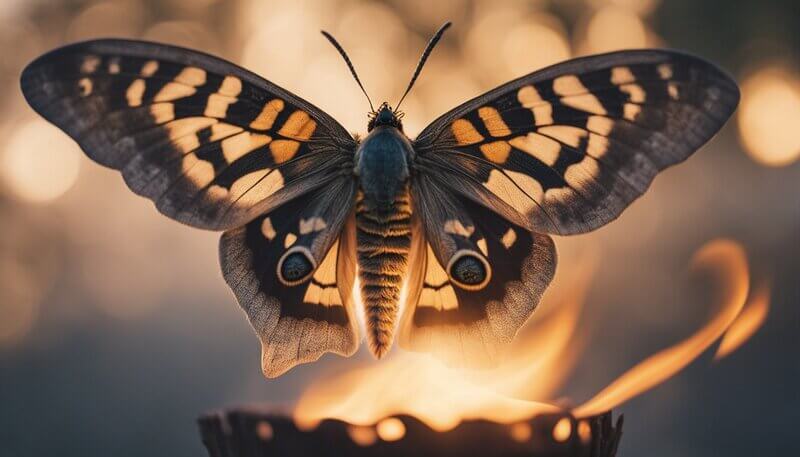
Understanding moths’ practical aspects involves recognizing their roles and behaviors in various environments, such as households, the textile industry, and agriculture. These aspects reveal their influence on our daily lives and the importance of mindful coexistence.
Moths in the Household
In many homes, moths are often seen as uninvited guests, mainly when they exhibit an attraction to light. This can lead to a nightly ritual of them fluttering near lamps or windows, driven by their innate navigation system.
However, their presence is not solely for irritation; moths play a role in the ecosystem by pollinating plants, similar to their daytime counterparts, like the hummingbird.
The key is to manage their presence without disrupting this natural balance.
Moths and Textiles
Moths are known for their determination when finding food sources, including clothing and textiles.
Their larvae stage is accountable for the weaknesses in garments, rugs, and other fabrics.
This highlights the importance of proper textile care, emphasizing camouflage techniques like mothballs and cedar closets to repel these insects without harmful effects.
- Methods to deter moths from textiles:
- Use airtight containers for storage
- Clean clothes thoroughly before storing
- Employ natural repellents, such as lavender or cedar
Moths in Agriculture
In agricultural settings, moths play a dual role.
On the one hand, certain species are crucial pollinators, demonstrating devotion to their role in plant reproduction and, by extension, supporting farmers’ careers.
On the other hand, some species are pests, causing significant crop damage and displaying a ruthless motivation to feed, which unveils their vulnerabilities.
Integrated pest management strategies align with a more neutral yet practical approach, addressing the truth about their impact on agriculture.
- Strategies employed in agriculture to manage moths:
- Monitor and identify moth species accurately
- Utilize biological control agents, such as parasitic wasps
- Implement pheromone traps to disrupt mating patterns
Moths and Personal Development

As a spirit animal, the moth is often seen as a symbolic guide through a personal journey of transformation and change. It represents positive evolution within one’s life, echoing the moth’s metamorphosis from caterpillar to airborne beauty.
The moth’s attraction to the moon symbolizes a draw towards understanding deeper truths and psychic abilities.
Moths naturally inspire individuals to discover their true passions and determination to pursue dreams. Like the moth, guided by unseen forces towards the light, people are influenced to follow their internal compass. This often leads to personal growth and the unveiling of secrets and vulnerabilities.
In career and motivation, the moth spirit instills a sense of devotion and perseverance to thrive amidst life changes. It encourages an individual to adapt and transform, much like the moth, being resilient despite the fragility of its wings.
Moths compel one to listen to the silent language of intuition. This aids in navigation through dramatic shifts and professional landscapes.
The moth’s example teaches individuals to embrace transformation and change, not as something to fear but as an inevitable part of their personal growth story.
With their wings patterned to blend in the night, moths exemplify a natural wisdom in concealment. This suggests one’s strategy should sometimes be subtle and considerate of timing and environment.
This spirit animal’s presence in a person’s life marks a call for inner reflection, a moment to acknowledge one’s passion inherent to personal or vocational success, and a reminder to be resilient in the face of challenges.
Conservation Efforts for Moths
Moth conservation is crucial for protecting biodiversity and these nocturnal creatures’ ecological roles. Active research and targeted conservation strategies are central to safeguarding moth species and their habitats.
Research and Conservation
Efforts to conserve moths begin with thorough research to understand their complex ecology and the factors threatening their survival. Scientists study moth behavior, such as their well-known attraction to light, and implement monitoring programs to track population changes.
Conservationists then use this data to create informed management plans that can include:
- Creation of wildlife corridors to connect fragmented habitats.
- Regulation of outdoor lighting to minimize disruption to moth’s nocturnal activities.
- Habitat restoration projects targeting the specific needs of moth species.
Research also includes the study of moth-predator relationships and the impact of environmental change on moth populations.
Importance of Preserving Species
The preservation of moth species is crucial for maintaining ecological balance. Moths play a significant role in their ecosystems as pollinators and as a food source for other animals.
Conservation efforts consequently safeguard the more considerable biodiversity of many ecosystems by protecting moths. Moreover, conserving moth species contributes to:
- The health of local plant life through adequate pollination.
- The stability of food webs, as they serve as prey for various predators.
Conservation work creates a haven for moths and supports the intricate web of life in which they are entwined. Through these endeavors, moths’ nuanced symbolism, representing transformation and adaptation, is honored in the practical realm of ecological preservation.
Reflective and Meditative Practices with Moths
In spiritual practice, moths embody notions of intuition, change, and the importance of trust and faith in the unseen. Individuals might turn to the moth as a spirit guide to heal their inner selves and enhance their inner guidance. Here are some methods for exploring this profound connection through meditation and reflection.
Featured Partner Offer
1. Headspace AppFeatured
〉 Hundreds of meditation videos, breathing exercises, and podcasts
〉 Daily routines & schedules accessible on the app or website.
〉 Diverse Content for Every Mood
〉 Engaging and User-Friendly Interface
Meditation Techniques:
- Visualizing Transformation: Envision a moth’s life cycle symbolizing personal change and growth.
- Guided Journey: Utilize the moth’s image to navigate the subconscious, seeking clarity and inspiration.
Rituals:
- Candle Gazing: Light a candle to represent the moth’s attraction to light, focusing on passion and optimism.
- Nighttime Reflection: Embrace the moth’s nocturnal nature to delve into vulnerability and explore instincts.
Inner Work:
- Journaling: After meditative practices, write down insights to consolidate reflection and understand spiritual meaning.
- Engage in consistent practice to recognize and accept the lessons moths offer, promoting a sense of inspiration and optimism.
Frequently Asked Questions
In exploring the role of moths as spirit animals, specific patterns and symbols are frequently encountered. These symbols have specific meanings in various cultural and spiritual contexts.
1. What does it mean to see a moth repeatedly?
Seeing a moth repeatedly may signify the need for greater attention to one’s intuition and inner wisdom. It is often interpreted as a message to trust in the subtle shifts guiding one’s path.
2. Are moths a good or bad omen?
Moths are traditionally seen as messengers, and whether they are considered good or bad omens varies by culture and individual belief. In many traditions, they represent change and transformation, and they do not carry intrinsic negative connotations.
3. How is a white moth connected to spiritual concepts?
A white moth is connected to spiritual concepts through its association with ancestors and the spiritual realm in various mythologies. It can symbolize purity, spiritual guidance, and the presence of a loved one’s spirit.
4. Can moths be considered a symbol of love in spirituality?
Yes, moths can symbolize love in spirituality as they are often drawn to light, which can be interpreted as seeking positivity or warmth in relationships. The Moth Spirit Animal is linked with clearer perceptions in matters of love.
5. What are the spiritual connotations of encountering a brown moth within the home?
Encountering a brown moth within the home can have spiritual connotations, such as symbolizing endurance, groundedness, and resilience. Brown is connected to the earth and may indicate the need for stability in one’s life.
6. How can one interpret the presence of a black moth in a spiritual context?
In a spiritual context, a black moth may represent the shadow self and the deep personal work one might need to undertake. It encourages introspection and understanding of the darker aspects of one’s personality.
7. What differentiates the moth and butterfly in spiritual symbolism?
The moth and butterfly carry different spiritual symbolisms.
The moth is commonly associated with nocturnal intuition and guidance. Meanwhile, the butterfly symbolizes transformation, hope, and the beauty of life’s unfolding.

